- 24H Open Interest$123,373,863,015.71-2.57%
- 24h Liquidation$344,999,822.930%
- 24h long/short Ratio48.73% / 51.27%
- Fear & Greed Index22
- Bitcoin Price$89,562.3-1.85%
- Ethereum Price$3,033.48-2.84%
- Solana Price$132.83-2.91%
- XRP Price$2.03-1.94%
- 24H Open Interest$123,373,863,015.71-2.57%
- 24h Liquidation$344,999,822.930%
- 24h long/short Ratio48.73% / 51.27%
- Fear & Greed Index22
- Bitcoin Price$89,562.3-1.85%
- Ethereum Price$3,033.48-2.84%
- Solana Price$132.83-2.91%
- XRP Price$2.03-1.94%
Best Crypto Options Platforms & Trading Strategies
If you are looking to trade crypto options, this guide will show you the best platforms for BTC and ETH contracts and learn pro strategies to manage risk.
Key Takeaways:
- Crypto options offer unique advantages over spot and futures: limited risk, flexible structure, and strategic control across market conditions.
- The top platforms in 2025, such as Bybit, Deribit, Binance, and OKX, differ in liquidity, fees, and features. Choosing the right one can be a key edge.
- From covered calls to straddles, knowing when and how to apply core options strategies can improve trade precision and risk management.
Bybit
Bybit, founded in 2018 and headquartered in Dubai, is the world’s second-largest exchange by volume, serving 60 million users with 1,800+ assets and over $11 billion in daily trading.
Features
Fees
Regulation
Overall Rating
Crypto options used to be a side product and now they’re a core part of how serious traders hedge risk, play volatility, or stay active when spot markets stall.
But not all platforms handle options well. Some are built for volume, others for structure, a few barely work at all. This guide filters out the noise and shows you which platforms actually deliver when the trade matters.
Best Crypto Options Platforms in 2025
We ranked the leading crypto options exchanges by what traders need most: strike depth, asset coverage, margin logic, and the ability to manage trades across time and volatility. The top picks let you trade single legs or complex spreads with clear fees, stable books, and interfaces that don’t get in the way.
This list is built for crypto-native traders who want fast, round-the-clock execution without the extra layers.
1. Bybit
Bybit holds the highest position on our list, due to its distinct advantage in the crypto options market by emphasizing control, clarity, and execution. Its European-style contracts, which are USDC-settled, eliminate exposure clutter and enable traders to concentrate solely on volatility plays and directional calls.
The platform supports a wide range of expiry dates, from daily to quarterly, giving traders the flexibility to time entries with precision. Portfolio Margin reduces capital requirements for offsetting positions, allowing risk-managed portfolios to scale more efficiently.
Bybit’s liquidity holds steady even during high-stress events, keeping order flow smooth and spreads tight across major pairs. With a UI that favors speed and accuracy, it is built for traders who value structure over spectacle.
Pros
- USDC-settled contracts reduce volatility and margin confusion.
- The platform supports BTC, ETH, SOL, and XRP with consistent uptime.
- Portfolio margin and unified account features improve capital efficiency.
Cons
- Only USDC is accepted as collateral, limiting flexibility.
- Lacks deep liquidity on altcoin options compared to BTC/ETH.
- Fewer strategy tools than Deribit or OKX.
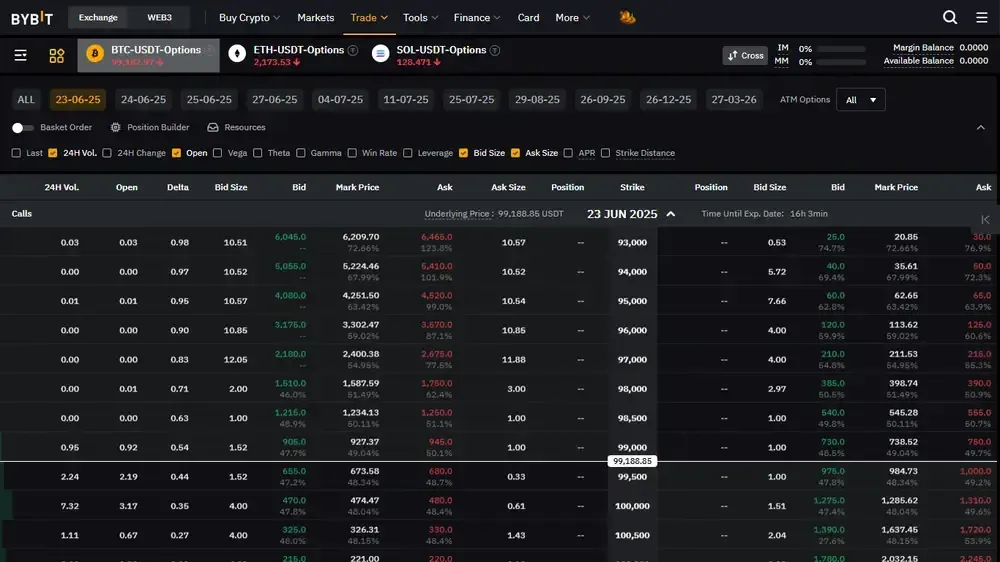
2. Binance
With over 700 listed contracts across BTC, ETH, BNB, SOL, XRP, and DOGE, Binance offers one of the broadest crypto options menus in the market. All positions settle in stablecoin, keeping margin, PnL, and position management clear even during volatility spikes.
Traders can express short-term views or hedge long-term exposure by simply paying the premium, with no leverage or collateral mechanics getting in the way. The platform supports a full menu of expiries and strike configurations, letting users shape trades with precision rather than forcing predefined setups.
It also incentivizes strategy, offering a leaderboard, performance insights, and API access for automation. For users who want scale without sacrificing simplicity, Binance makes options trading feel like a natural extension of the broader market experience.
Pros
- Offers over 700 contracts across multiple major coins.
- High liquidity and global reach make fills fast and competitive.
- Interface supports both quick trades and complex strategies.
Cons
- User interface can be overwhelming for newcomers.
- Options trading not available in restricted regions like the US.
- Some contracts suffer from inconsistent depth and spreads.
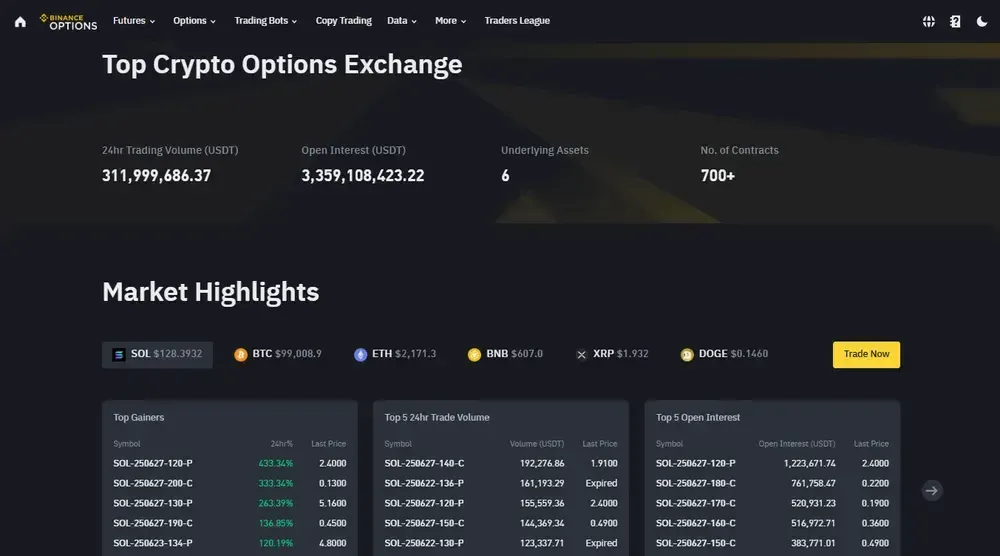
3. Deribit
Deribit handles more than 85% of global BTC and ETH options open interest, making it the platform of record for institutional and active traders. Its deep strike ladders, combo fee discounts, and mini-contracts support both heavy flow and tight strategies.
Traders can build advanced strategies using a wide range of strikes and expiries, supported by mini and regular contracts for broader flexibility. Fee breaks on multi-leg combos reward smart structure, making spreads and complex trades more cost-effective.
The platform is fast, stable under market volatility, and engineered for precision, with portfolio margining and analytics tools built into the interface. It’s unapologetically built for professionals, and for non-US traders, it’s still the closest thing crypto has to a true derivatives exchange.
Pros
- Deepest BTC and ETH options liquidity in the market.
- Full strategy support with tight spreads and wide expiry coverage.
- Trusted by institutions for speed and execution reliability.
Cons
- Limited to BTC, ETH, and a few select altcoins.
- Not available to users in the US or other restricted areas.
- Platform UI feels technical and less intuitive for beginners.
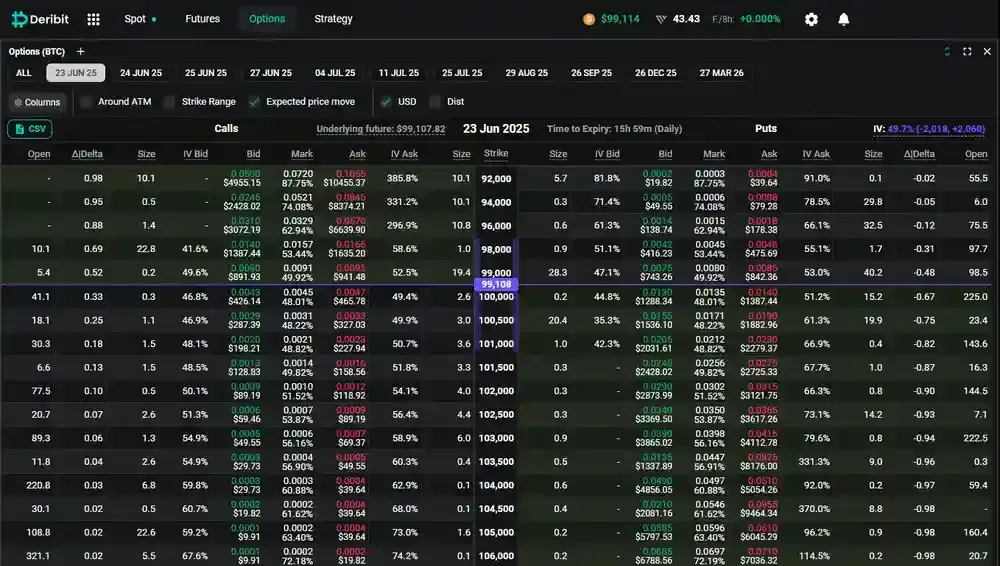
4. OKX
OKX supports BTC and ETH options with expiries from 1-day to quarterly, and uniquely settles in crypto (BTC/ETH), not stablecoin. The platform offers both a simple order flow and a multi-leg simulator, making it unusually versatile across experience levels.
Each contract settles in the underlying coin, not stablecoin, which makes PnL feel more native to crypto holders who already think in BTC or ETH. Expiry choices are diverse, and the unified margin system lets capital flow efficiently across spot, futures, and options in a single account.
Portfolio margin is active across spot, futures, and options, letting capital stretch across multiple instruments without siloed risk. Add in solid liquidity, competitive fees, and a custom strategy builder, and OKX quietly becomes a favorite for hybrid traders who want speed and control without complexity.
Pros
- Dual-mode interface caters to both beginners and pros.
- Strong analytics with greeks, payoff diagrams, and volatility data.
- Portfolio margin across products improves capital use.
Cons
- Liquidity still trails Deribit and Binance for major expiries.
- Options available only for BTC and ETH.
- Some features may require higher-tier account access.
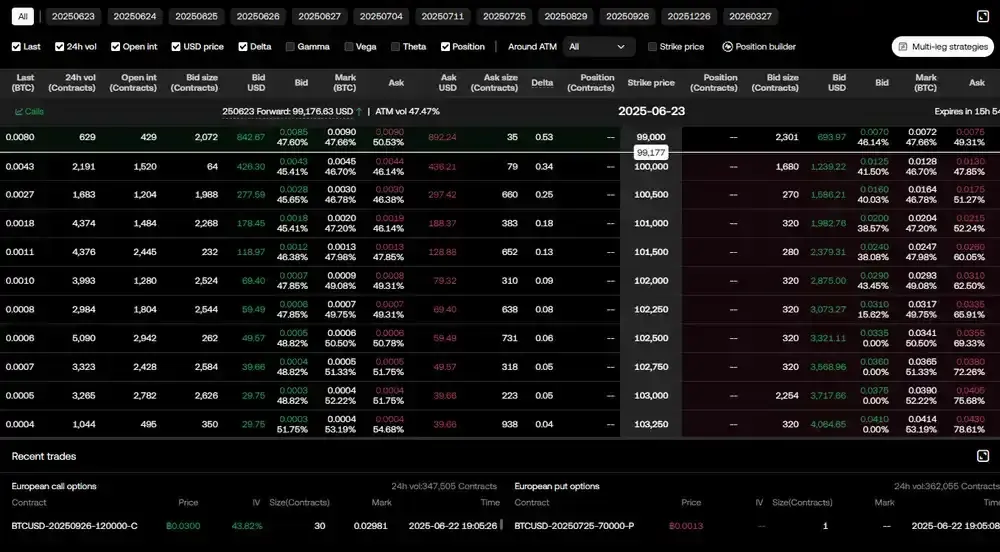
5. Gate.io
Gate.io currently lists only BTC options, European-style and USDT-settled, with a retail-friendly interface and low capital barrier. You can buy puts or calls with a few clicks, but you won’t be writing contracts or executing complex trades here.
Only buy-side trades are allowed, meaning users can purchase calls or puts but cannot write options or construct more advanced strategies. Expiry selection is reasonable, but spreads are wide and liquidity tapers off quickly outside near-term, near-the-money strikes.
Gate’s strength lies in convenience; if you already hold BTC on the platform and want quick downside protection, it’s easy to execute. Serious options traders will find the toolset too limited, but for passive hedging, Gate covers the basics without complexity.
Pros
- Simple BTC options product with stablecoin settlement.
- Clean interface is easy to understand for first-time users.
- Useful for hedging if you already hold BTC on the platform.
Cons
- No ability to sell (write) options limits strategy use.
- Low liquidity and wide spreads reduce execution quality.
- Minimal analytics or strategy tools are available.
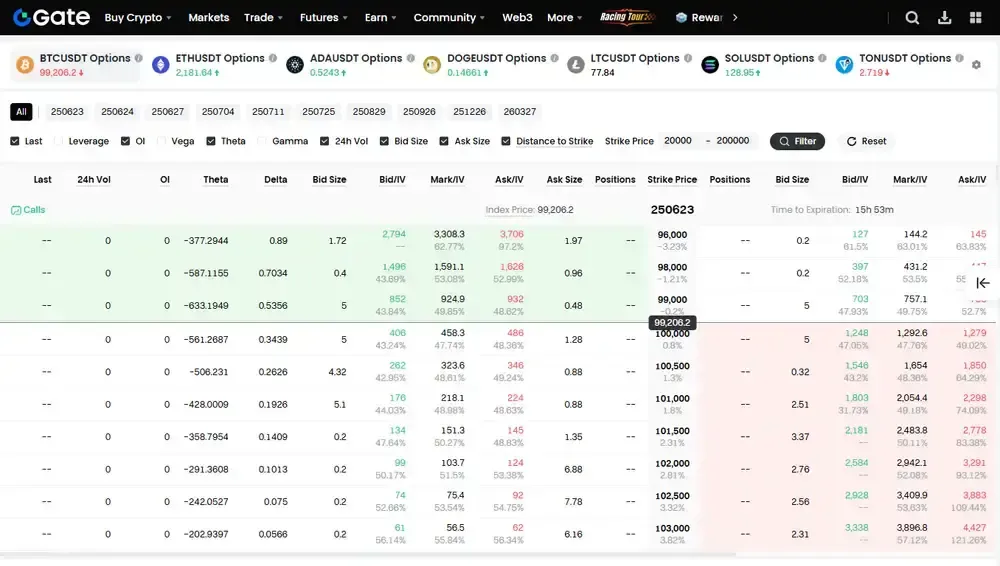
6. HTX
HTX supports BTC and ETH options into its derivatives suite with a focus on long-only trades and stablecoin settlement. Contracts are in either European or American style, with built-in suggestions for vertical spreads aimed at helping users control risk and cost.
The platform promotes structured trades like vertical spreads, encouraging users to control premium costs and manage risk more clearly. While you can’t write options or run complex strategies, the interface makes buying directional exposure intuitive and low-friction.
Liquidity is serviceable for near expiries and at-the-money strikes, though deeper trades may face slippage or thin books. HTX doesn’t chase advanced analytics but offers enough tooling to help new users explore options without getting overwhelmed.
Pros
- Supports long calls and puts on BTC and ETH.
- Vertical spread suggestions help users learn structured trades.
- Smooth mobile and desktop integration for ease of access.
Cons
- Only supports buying options, not writing them.
- Analytics are basic and lack depth for advanced planning.
- Trust concerns remain due to past transparency issues.
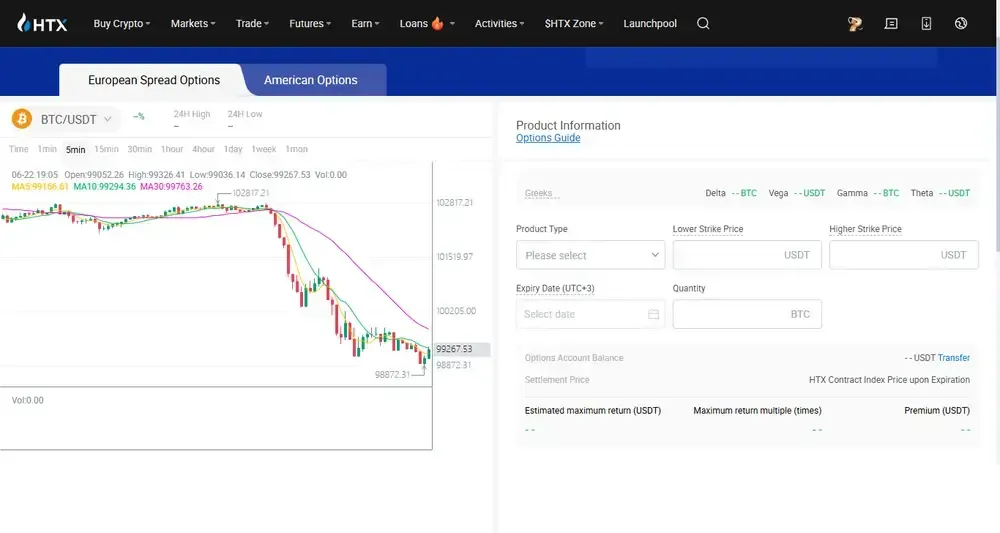
7. KuCoin
KuCoin offers BTC and ETH options starting from just 10 USDT per contract, making it one of the lowest entry points on the list. Expiries include weekly, bi-weekly, and monthly, and positions auto-settle in USDT with capped trade and exercise fees.
The interface is clean and integrated into KuCoin’s broader trading app, offering simplified chains and mark pricing based on the Black-Scholes model. Only long positions are supported, which keeps risk capped but limits more advanced strategy construction for experienced users.
Liquidity is modest but growing, especially around short-term BTC strikes, and the exchange caps all trading and exercise fees to prevent overcharging on small trades. With tutorials, a test mode, and a large retail base, KuCoin positions options as an easy add-on for spot and futures users looking to expand.
Pros
- Very low entry barrier with small contract sizes.
- Auto-settlement and simple UI make it beginner-friendly.
- Educational tools and test mode help users learn safely.
Cons
- Only supports BTC and ETH options at this time.
- Liquidity is limited, especially for long-dated strikes.
- Does not support writing options or advanced structures.
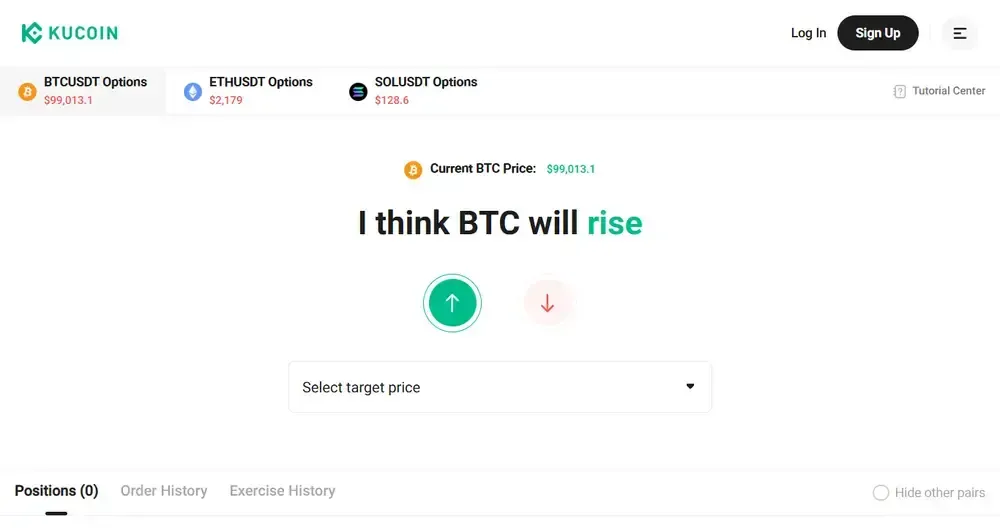
What are Crypto Options?
Crypto options are trading contracts that give you the right to buy or sell a digital asset at a specific price on a future date. What sets them apart from other crypto derivatives is that you are never obligated to follow through; you can walk away if the market does not move your way.
Each contract is built around an underlying asset like BTC or ETH, usually priced in stablecoins, and tied to a defined expiry window. Some expire daily, others stretch into weekly, monthly, or quarterly cycles. You pay a premium to enter the trade, pick a strike price, and wait to see if the market crosses your line.
Options are not just about picking a direction. You can build positions that pay off when price moves, when it doesn't, or when it moves fast but unpredictably. The mechanics can get complex, but the power is simple: limit your risk, and define your edge before the trade even begins.
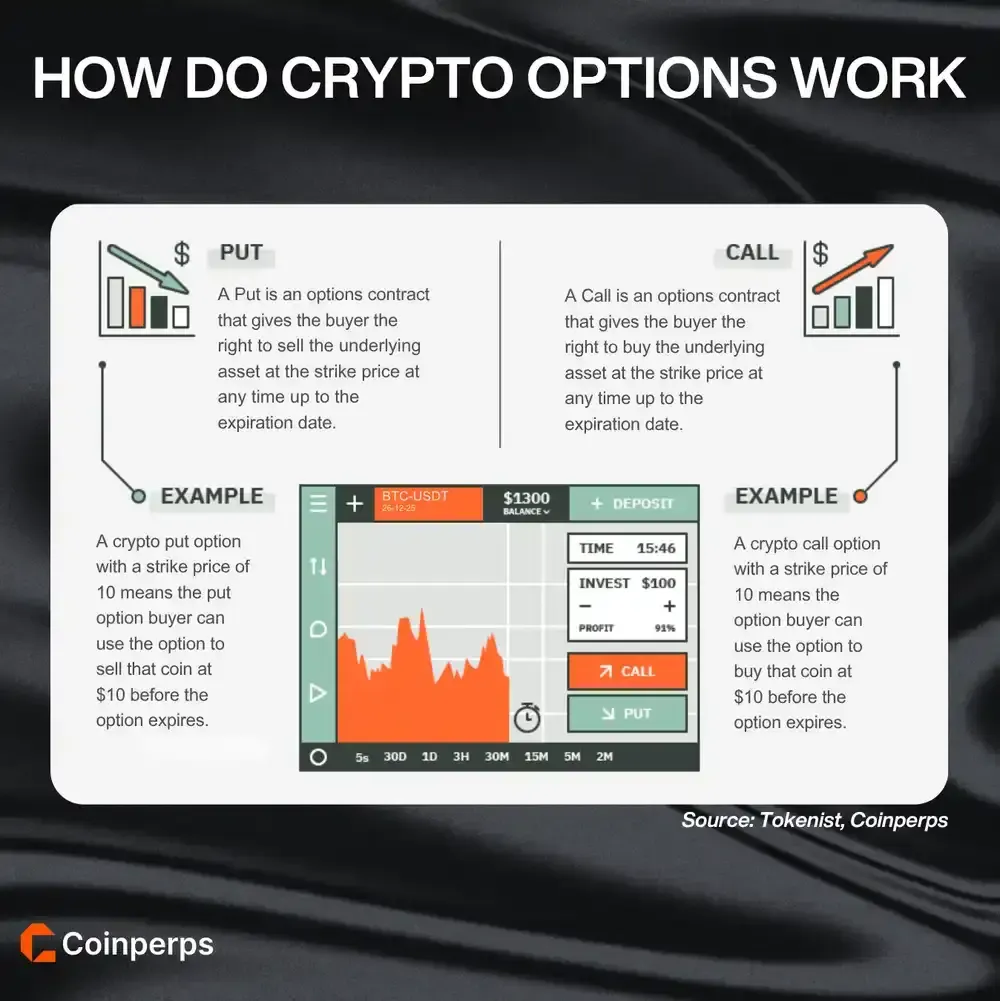
Key Terms in Crypto Options
If you’re trading options, the platform might show you a clean order form, but the terminology behind it comes from decades of derivatives trading. These are the core ideas baked into every trade you place, whether you’re buying a simple call or structuring a full volatility spread.
Quick guide to crypto options terminology:
- Call: A call option gives you the right to buy the asset at a specific price before or at expiration, often used when you expect the market to move upward and want defined risk with leveraged upside.
- Put: A put option gives you the right to sell the asset at a specific price before or at expiration, typically used to protect against falling prices or to take a bearish view with limited downside.
- Strike Price: This is the fixed price written into the contract where the option can be exercised; it acts as the trigger point for profit or loss when comparing to the market price at expiration.
- Premium: The premium is what you pay up front to enter the trade, and for buyers, it represents the maximum amount you can lose if the option expires without value.
- Expiration: Every option comes with an expiration date that determines when the contract settles; if the conditions for profit are not met by that moment, the option ends worthless.
- In the Money: An option is considered in the money if it would make a profit right now; for a call, that means the market price is above the strike, and for a put, it means the market is below the strike.
- Implied Volatility: This is the market’s forecast of how much the asset is likely to move before expiration, and higher volatility usually makes options more expensive due to greater potential outcomes.
- Delta: Delta measures how much the option price is expected to change when the asset price moves by one unit, and it also gives you a rough idea of the probability that the option will finish in the money.
Options trading also includes deeper mechanics that become important as you gain experience, such as in-the-money probabilities, volatility skews, and max pain. These concepts help explain why prices behave a certain way near expiry and why some strike levels tend to attract price action.
Example Crypto Options Trading Strategies
Every options trade is built on the same inputs: strike, premium, time, and direction. Strategies combine these into defined setups that behave differently depending on market conditions. Some work best when volatility is rising, others when price stays still.
Below are four core approaches used by traders to manage risk, seek edge, or structure payoff.
Covered Call
The "covered call" is a strategy for earning extra income from coins you're already holding when you expect price to stay flat or drift. You sell a call option at a strike above the current price, collecting a premium that you keep as long as the asset doesn't rally past that level.
When to use: Popular with long-term holders during slow markets.
Example: You hold 1 BTC bought at 101800 and sell a 106000 call for 800 USDT. If BTC finishes below 106000 at expiry, you keep both the BTC and the premium.
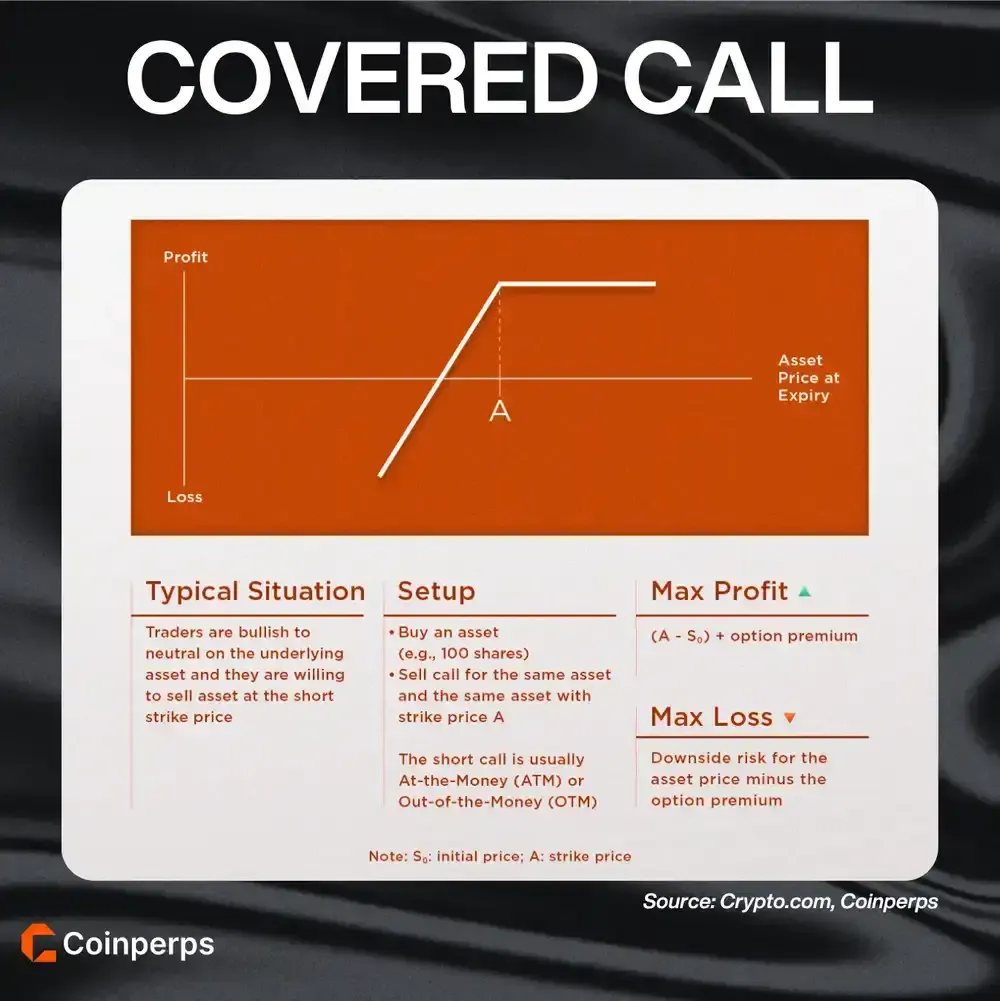
Protective Put
A "protective put" acts as insurance when you're worried about downside but don't want to sell your position. You buy a put option with a strike below market, setting a worst-case exit price if the asset crashes. The cost of the put is your tradeoff for peace of mind, and if the market goes up, you lose only the premium.
When to use: Before high-risk events like earnings or major news.
Example: You hold 1000 SOL at 135 and buy a 120 put for 2.5 per coin. If SOL drops to 100, you can still sell at 120, limiting your loss to the premium paid.
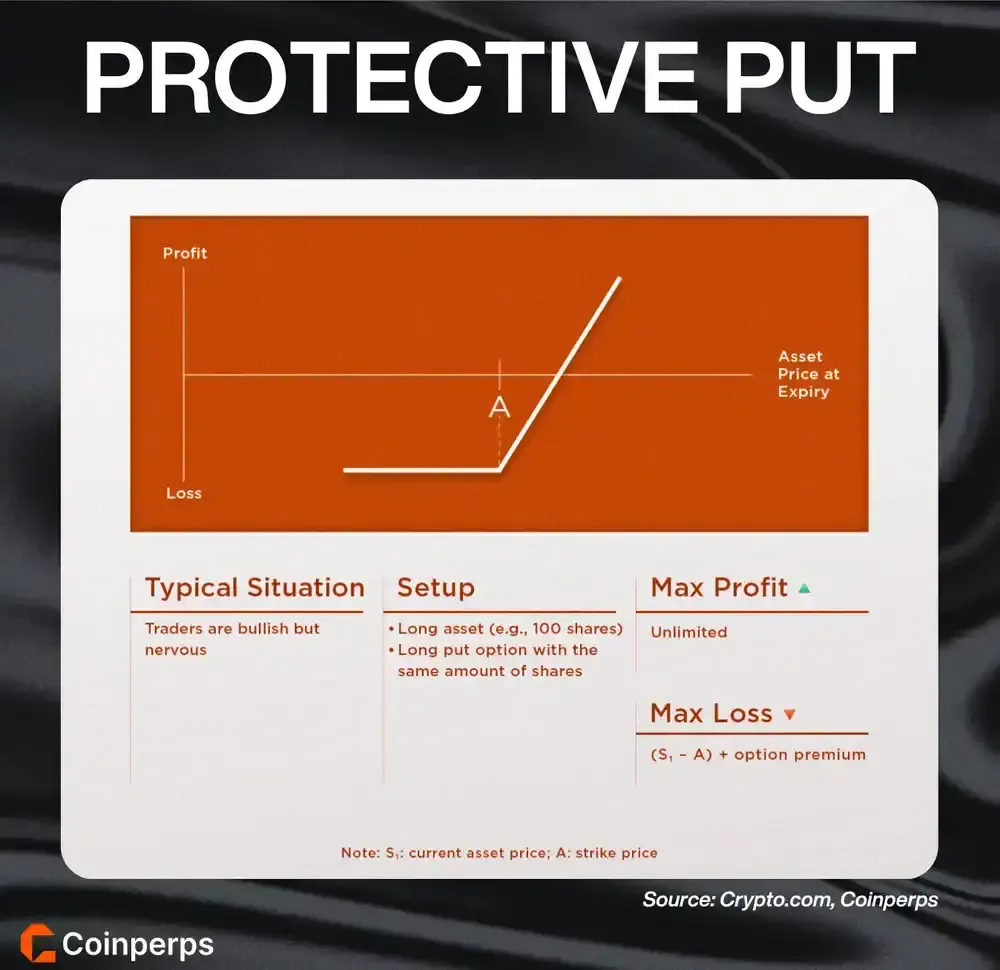
Long Straddle
The "long straddle" is a volatility play when you expect a large move but don't want to guess the direction. You buy a call and a put at the same strike and expiry, betting that one side will gain more than the combined cost of both. If price moves far enough in either direction, the trade can be profitable.
When to use: Works best before events like CPI prints, Fed meetings, or earnings.
Example: Buy an ETH 2200 call and 2200 put, each for 40 USDT. If ETH moves to 2360 or drops to 2040 before expiry, one leg becomes valuable while the other expires worthless.
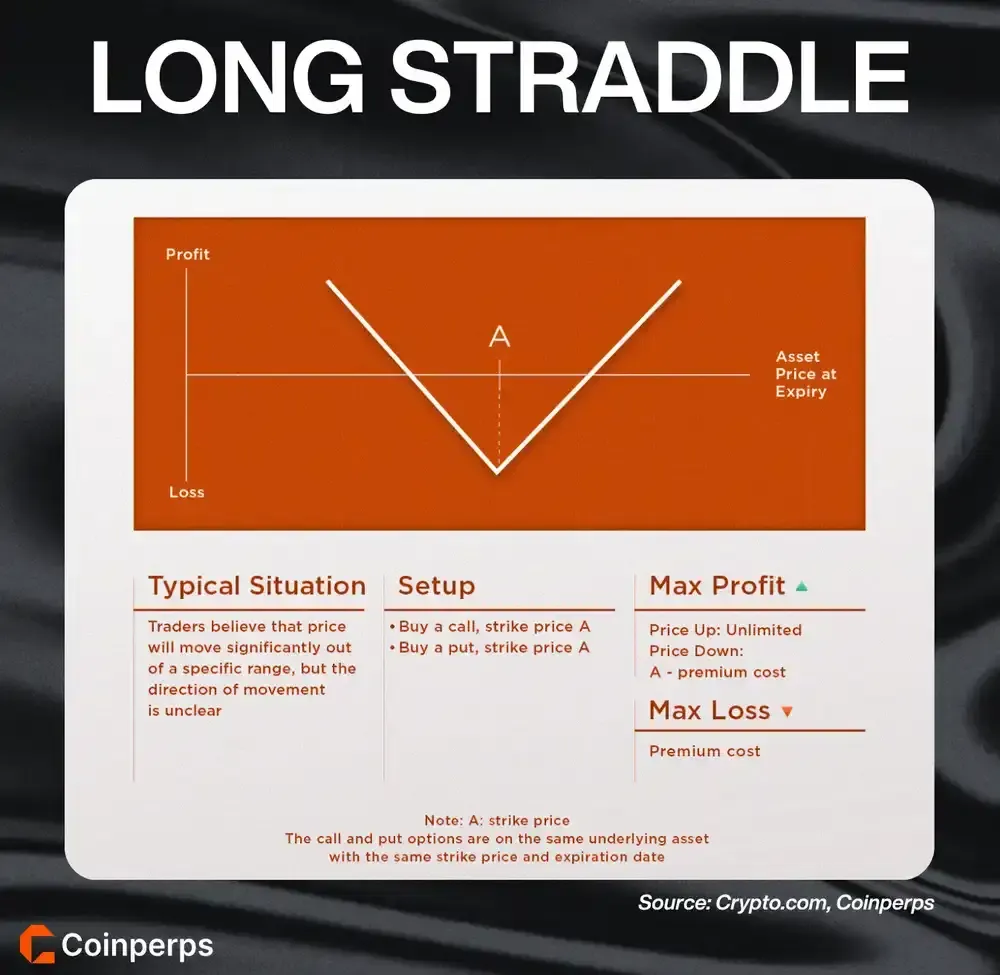
Iron Condor
An "iron condor" is a neutral strategy that profits from time decay and low volatility. You sell a put spread below market and a call spread above, collecting premium from both sides. The trade wins if the asset stays between the inner strikes until expiry, and the risk is defined by the width of each spread.
When to use: During quiet weeks when no big moves are expected.
Example: On BTC at 102000, you sell a 98000-96000 put spread and a 108000-110000 call spread. If BTC stays between 98000 and 108000, both spreads expire and you keep the full premium.
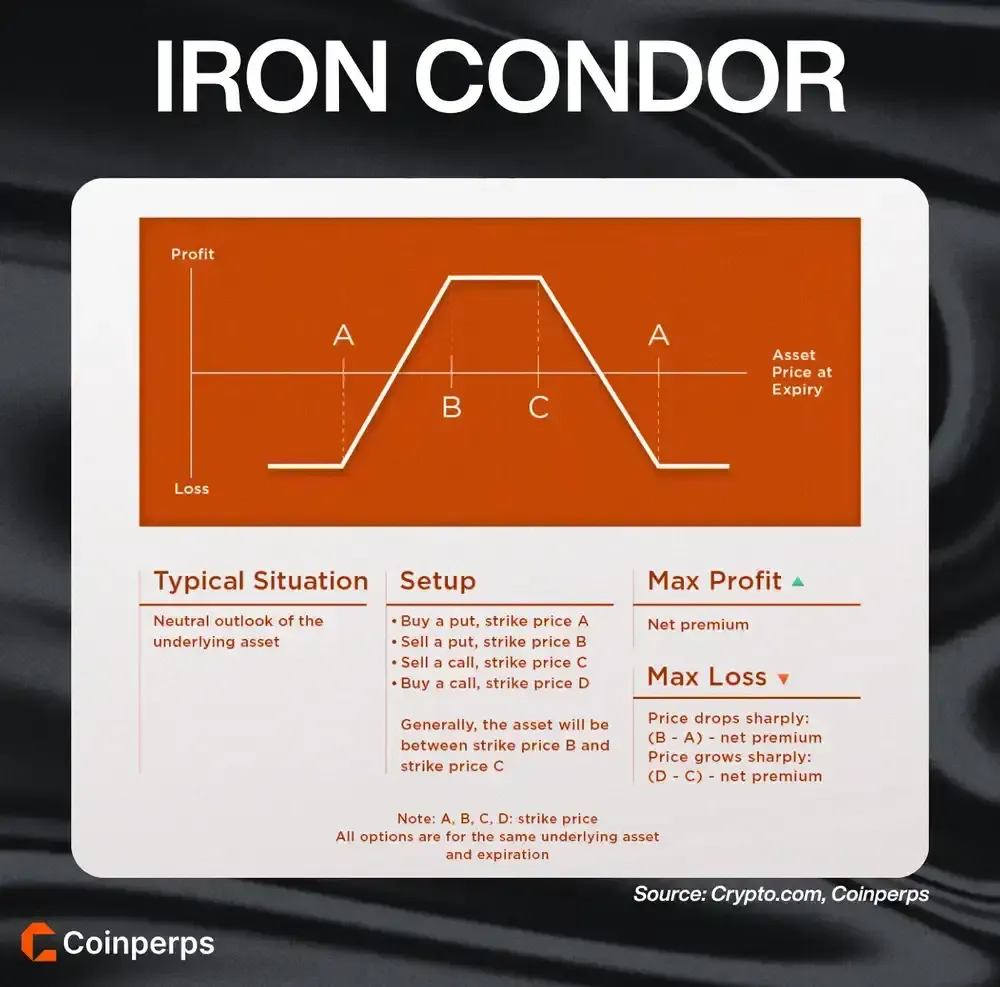
Bottom Line
If you’ve been putting crypto options off, brushing them aside as “too complex” or “for later,” you’re not alone. But the market doesn’t wait, and neither does opportunity.
Options give you tools that spot and futures can’t: timing, control, and asymmetry when it matters most. They might be a worthwhile addition to your trading arsenal, especially if you’re already active on one of the platforms we’ve covered.
Frequently asked questions
European options can only be exercised at expiration. Most crypto platforms (such as Deribit and Binance) use this model for simplicity and consistency.
Most crypto options platforms charge a fee per trade based on the notional value of the contract, typically around 0.02% to 0.05%. Some also charge a separate exercise fee if the option finishes in the money.
Platforms may set a minimum fee per contract, and in some cases, offer discounts for high-volume traders or multi-leg strategies. Always check whether fees are charged on both entry and exit, and if there are limits or caps on total fees per trade.
This depends on your jurisdiction. In many countries, options are treated as capital gains or derivatives income, so consult a tax advisor for specifics.
Yes. Most crypto options platforms are cash-settled, meaning you can trade them without owning BTC or ETH. Profit and loss are settled in USDT or another stablecoin.
While both are derivatives, crypto options give you the right to trade, whereas futures come with an obligation. With options, your downside is limited to the premium paid, and you can build asymmetric trades (small risk, larger potential gain).
Futures, on the other hand, offer linear exposure, where gains and losses move 1:1 with the market, which can mean high risk without protection. Traders often use options for hedging or volatility plays, while futures are more suited to directional bets and high-leverage trades.
.avif)